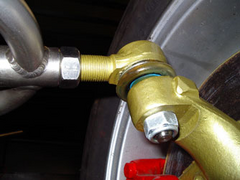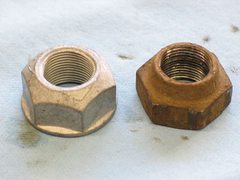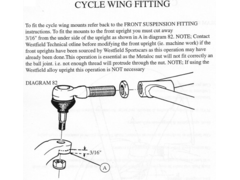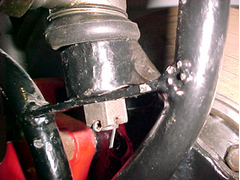
Rescued attachment chassis and clutch 072.jpg

OK we are familiar with the problem - Not enough thread showing etc. I would be interested to know what people have done here.
No problen turning a couple of mm off a nut (as I have a lathe) but to get a couple of threads to show makes a pretty damn thin nut!
Do we need threads showing if the nut is castle nut/split pin?
Just how thin do we think this nut can be?
After having a nut strip its threads and cause a wheel collapse I have now checked this over.
It would appear with a new balljoint fitted that the end of the thread/beginning of the taper is actually further up in the upright hole.
I have now carefully dressed the underside of the upright top and removed approx 2-3mm from the nut land area.
This allows more thread exposed and the nut to lock down correctly.
I have radiused the area to the back of the hole to avoid any stress point.
A precaution I believe because the original had a very sharply defined cut off.
The amount of metal in the top joint fastening is not compromised by this and certainly appears of adequate thickness to accomodate a few mm of metal
removal.
I hope my description makes sense.
Rob Lane
[Edited on 10/8/07 by Rob Lane]
I haven't got a car assembled to fully understand this thread. Any pics would be helpful!
So with shortening the upright, problem solved?
I like the idea better than shortening the nut.
One thing is also important, let the coilover do the stop in full drop and not the transit ball-joint.
Btw: i'm using the M20x1,5 version, which has the same problems.
quote:
Originally posted by SyKaTurbo
I haven't got a car assembled to fully understand this thread. Any pics would be helpful!


So it's take the whole f***ing assembly apart then. I really didn't want that.
Oh well, that's life. Just a thought - has anyone cottened on to this and started knocking them out with a little more thread.
Or-do some makes have a little more thread than others, anyhow?
By the way 907 - that's before you put your cycle wing stay under the nut! If, of course, that's the route you're going.
Anyone reamed the hole?
Ah right, i'll be using the Sierra upright so don't think it will apply to me.
Does look a little dodgy. Can you not use one of the nuts with the flat bottom and a deformed thread to lock it in place?


Rescued attachment locknut.jpg
quote:
Originally posted by The Doc
By the way 907 - that's before you put your cycle wing stay under the nut! If, of course, that's the route you're going.
OK I've done a lttle research and found that the ball joints are not identical. With some the thread stops much sooner than others which have a
couple of threads missing in favour of a 'shoulder'.
I think I'm going to pursue the line of acquiring the joints with the longest thread I can find, castle nut and a new hole drilled for a split
pin as near the end of the thread as I dare
quote:
Originally posted by 907
Would reaming squash the rubber cup too much?
My TREs came with different thread lengths one with a castle nut the other with a Nyloc. No surprise the one with the nyloc is nearly OK the other is
no way! I am inclined to grind a fresh flat for the nut to land on and drill and pin full nuts on to the TREs.
Caber
Here's a copy what it says in my Westfield build manual:


Rescued attachment westie-upright-mod.jpg
Well, if it's good enough for the
Westfield Technical Otline
it's good enough for me.
Paul G
thanks David for finding that.
That's exactly what I have done to get the thread fully exposed.
The thread failure could be down to one or two things.
The lack of threads fastening in nut.
Wrong nut fitted. i.e. less than 8.8
The second is quite possible, I have had them apart a few times whilst fabricating new wishbones and may have used a 'soft' nut.
The balljoint threads still had full thread shards left in them, suggesting stripping by wrong type of nut. (My fault)
To be sure this time, as well as thinning the upright slightly I'm going to drill and lockwire the nut !!!
In the end I put the ball joints on the lathe - just do-able with my lathe set up and turned 1mm off the taper. A shave off the castle nuts and
it's looking good.
We still have the full range of movement in the ball joint and the rubber boot is not unduly squashed.
All seems fine - Anyone else go this route?
I'll put some pics up later
Mike
Here it is fitted
Well it is now!


Rescued attachment Castle Nut.jpg
No it's not - what's the problem here?
There it is!